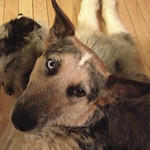Oh, here it is.
So for us it is simply another endocrine organ excreting useful chemicals to control growth. Odd that it should be associated with vision in reptiles and amphibians .. yet in an entirely different manner than how the eye works. I suppose its use is merely to regulate hormone production depending on the season and day length. Funny what my imagination did with this back then. I wonder why the Tautara was singled out back then for mention in regard to this organ?
wiki Wrote:The parietal eye is a part of the epithalamus, which can be divided into two major parts; the epiphysis (the pineal organ, or pineal gland if mostly endocrine) and the parietal organ (often called the parietal eye, or third eye if it is photoreceptive). It arises as an anterior evagination of the pineal organ or as a separate outgrowth of the roof of the diencephalon. In some species, it protrudes through the skull.[4] The parietal eye uses a different biochemical method of detecting light than rod cells or cone cells in a normal vertebrate eye.
So for us it is simply another endocrine organ excreting useful chemicals to control growth. Odd that it should be associated with vision in reptiles and amphibians .. yet in an entirely different manner than how the eye works. I suppose its use is merely to regulate hormone production depending on the season and day length. Funny what my imagination did with this back then. I wonder why the Tautara was singled out back then for mention in regard to this organ?










![[Image: Peacockspider2_large.jpg]](https://images.weserv.nl/?url=www.abc.net.au%2Fcatalyst%2Fstories%2Fimg%2FPeacockspider2_large.jpg)
![[Image: map?q=lsid:%22urn:lsid:biodiversity.org....osher:true]](https://images.weserv.nl/?url=biocache.ala.org.au%2Fws%2Fdensity%2Fmap%3Fq%3Dlsid%3A%2522urn%3Alsid%3Abiodiversity.org.au%3Aafd.taxon%3A22bb7be7-c149-4853-969a-a80a8221fd4c%2522%2520AND%2520geospatial_kosher%3Atrue)
 pisthothelae
pisthothelae![[Image: 5521738809_943a116aa7_b.jpg]](https://c2.staticflickr.com/6/5296/5521738809_943a116aa7_b.jpg)
![[Image: guilmon_evolution_by_davidgtm3-d4gb5rp.gif]](https://images.weserv.nl/?url=orig15.deviantart.net%2F1dbf%2Ff%2F2011%2F319%2F3%2F3%2Fguilmon_evolution_by_davidgtm3-d4gb5rp.gif) https://www.youtube.com/channel/UCOW_Ioi2wtuPa88FvBmnBgQ my youtube
https://www.youtube.com/channel/UCOW_Ioi2wtuPa88FvBmnBgQ my youtube
![[Image: Haarbalgmilbe.jpg]](https://images.weserv.nl/?url=upload.wikimedia.org%2Fwikipedia%2Fcommons%2F0%2F0e%2FHaarbalgmilbe.jpg)
 emodicidae
emodicidae![[Image: follicle_mite_demodex_folliculorum_colou...445314.jpg]](https://images.weserv.nl/?url=www.visualphotos.com%2Fphoto%2F1x6029726%2Ffollicle_mite_demodex_folliculorum_coloured_sem_z445314.jpg)
![[Image: Ohmdenosaurus-1.jpg]](https://images.weserv.nl/?url=img1.wikia.nocookie.net%2F__cb20130623232144%2Fdinosaurs%2Fimages%2F6%2F64%2FOhmdenosaurus-1.jpg)
![[Image: 250px-Ohmdenosaurus.JPG]](https://images.weserv.nl/?url=upload.wikimedia.org%2Fwikipedia%2Fcommons%2Fthumb%2F2%2F23%2FOhmdenosaurus.JPG%2F250px-Ohmdenosaurus.JPG)
![[Image: 6a10b74e5e4de4188208d3d130713921.jpg]](https://images.weserv.nl/?url=media-cache-ec0.pinimg.com%2F236x%2F6a%2F10%2Fb7%2F6a10b74e5e4de4188208d3d130713921.jpg)
 lacentalia
lacentalia![[Image: Hobbit2sm.jpg]](https://images.weserv.nl/?url=www.d.umn.edu%2Fcla%2Ffaculty%2Ftroufs%2Fanth1602%2Fimages%2FHobbit2sm.jpg)
![[Image: barn-owl.jpg]](https://images.weserv.nl/?url=media-cdn.tripadvisor.com%2Fmedia%2Fphoto-s%2F01%2F1b%2F60%2Fa7%2Fbarn-owl.jpg)
![[Image: Barn%20Owl.jpg]](https://images.weserv.nl/?url=www.avibirds.com%2Fmigration%2FBarn%2520Owl.jpg)
![[Image: owl-in-the-roof.jpg]](https://images.weserv.nl/?url=www.factzoo.com%2Fsites%2Fall%2Fimg%2Fbirds%2Fowls%2Fowl-in-the-roof.jpg)
![[Image: 288px-Waterbear.jpg]](https://images.weserv.nl/?url=upload.wikimedia.org%2Fwikipedia%2Fcommons%2Fthumb%2F0%2F08%2FWaterbear.jpg%2F288px-Waterbear.jpg)
![[Image: animal_Hypsibius_dujardini02_02.jpg]](https://images.weserv.nl/?url=niyas.xsrv.jp%2Fattoexa%2Fwp-content%2Fuploads%2F2011%2F03%2Fanimal_Hypsibius_dujardini02_02.jpg)
